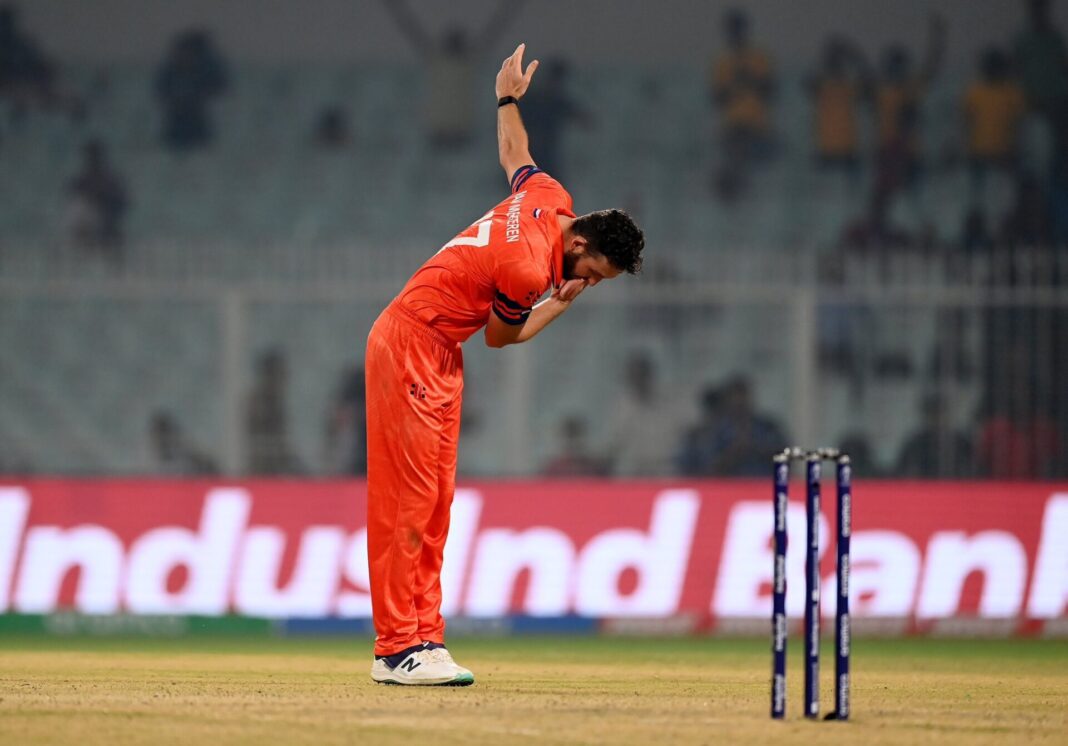Ryan Cook and Scott Edwards talked, as they really had to do, about semi-final ambitions as they set out for India, unaware like everyone else that the ICC had given them a realistic alternative aim – qualification for the next Champions Trophy – but omitted to tell anyone about it.
In the event, stunning victories over South Africa and Bangladesh weren’t enough to lift them off the bottom of an intensely competitive table, but there were opportunities elsewhere which could, and perhaps should, have seen them squeeze into the top eight – after all, one more win would have got them there.
As the dust settles, it’s time to reflect on what went well in the toughest tournament the Dutch men’s team has ever faced, and where the weaknesses were which prevented even greater achievements.
On the plus side, Edwards’ side impressed everyone with their disciplined bowling, especially in the middle overs, and the commitment, and at times brilliance, of their fielding. Edwards himself earned plenty of credit for his management of his bowlers and for some inventive field placings, often the result of meticulous planning by coach Cook and his back-room team.
Individually, 20-year-old off spinner Aryan Dutt was consistently impressive, taking the new ball and containing all but the most accomplished and destructive of opposing openers, while of the faster men Paul van Meekeren was again the pick of the bunch, using his height to unsettle even established batters with bouncers and claiming much-needed wickets.
In a batting side which generally struggled, newcomer (to the Dutch squad at least) Sybrand Engelbrecht added a welcome degree of solidity to the middle order and emerged the leading run-scorer with 300 at 37.50, although circumstances inevitably meant that his strike rate, at 66.67, was less overwhelming.
Like Engelbrecht, skipper Edwards posted two half-centuries and averaged 37.00, but despite a healthier strike-rate of 86.91 he was less dominant on this stage than he had been during the Super League and the subsequent Qualifier.
Five other batters – Vikram Singh, Colin Ackermann, Bas de Leede, Teja Nidamanuru and Logan van Beek – had a single fifty, but Edwards’ match-winning, unbeaten 78 against South Africa was the highest individual score, and there was only one century partnership, that between Engelbrecht and Van Beek against Sri Lanka.
Which brings us to one of the most severe limitations of the side: the inability of the top order to give the team a solid start.

Only once in the nine games did the openers get through the first six overs without one of them falling (against South Africa the first wicket came off the first ball of the seventh), and only twice, against Afghanistan and India, did the initial powerplay produce more than 50 runs.
No doubt Cook and his players will devote a good deal of attention to the technical issues which may have contributed to this, but no-one who watched the Dutch dealing with the pace, swing and variations of Mitchell Starc and Josh Hazlewood, or Chris Woakes and David Willey, could fail to reflect on the fact that even the Super League could not entirely prepare one for that kind of supreme test.
That said, Singh, Max O’Dowd, Barresi and Ackermann all demonstrated that given any width at all they could unleash some glorious strokes, and Singh’s back-to-back boundaries off Hazlewood, to name just one example, will live long in the memory, as will O’Dowd’s dismissal of Mohammed Shami over the square leg boundary.
It was not, however, only the menace of the world’s best new-ball attacks which caused the Dutch batters problems: the Netherlands’ traditional weakness against quality spin bowling was also apparent, never more so than against Sri Lanka, Afghanistan and India.
These are not issues which are likely to be resolved by a three-year diet of League 2 matches against fellow-Associates like the USA, Oman and Nepal, but that is a topic for another day.
As are the structures of Dutch domestic cricket, and the pitches on which Dutch domestic competitions are played, neither of which is optimal for the development of young players capable of holding their own at the highest international level.
Given all this, it’s remarkable that the Netherlands, along with five players of South African origin, three from New Zealand and one from Australia, were able to include in their squad six who had come up through the Dutch youth system, three of them (Dutt, Singh and Shariz Ahmad) just 20 years of age.
Then there’s Bas de Leede, still only 23, the side’s leading wicket-taker in the tournament and a much better bat than he was able to show here, his 67 against Pakistan excepted; he was the most expensive of the regular bowlers at 7.27 an over, but his strike rate of 25.13 was far and away the best for the side and fifth in the tournament among those who bowled 50 or more overs.
🆕 New #ECPod!
🎙️ @HeliocentCric and @tomgrunshaw chat Netherlands at #CWC23, the Asia T20 Qualifiers and more!
🟢 https://t.co/ujoT7EcKH5
🍎 https://t.co/ozldCqhly8
🎧 https://t.co/FpBGxSiIdp— Emerging Cricket (@EmergingCricket) November 10, 2023
Near the other end of the age scale, Roelof van der Merwe bowled some fine spells, and he, Dutt and Ackermann, the three main spinners, were the only regular bowlers in the side to go at less than six an over, no mean achievement when one recalls who they were bowling to.
If getting away to a good start in the initial powerplay was a problem for the batters, the bowlers tended to struggle increasingly in their opponents’ first ten overs, and even more at the death: across the five innings which went the full distance the Dutch conceded an average of 105 in the final powerplay, although of course they were not the only ones who suffered when powerful batters were still at the crease and well set in those closing overs.
On tracks prepared for the batters, often paired with shortish boundaries, even the finest bowlers can struggle, and we must also remember that the Netherlands were deprived of the services of the injured Fred Klaassen, whose left-arm bowling could have made a big difference at both ends of opponents’ innings.
Cook and Edwards have signalled their reluctance to be seen as leaders of an Associate team, but as the poet Robert Burns remarked, ‘facts are chiels that winna ding’ [‘facts are guys you can’t argue with’], and the fact remains that the Netherlands continues to labour under all the limitations of funding, participation and competitive opportunity imposed on them by a fundamentally inequitable global system.
That they won through to the World Cup was remarkable in itself, that they beat South Africa – for the second time in successive global tournaments – and Bangladesh was truly extraordinary, and the whole squad can be immensely proud of what they have achieved, for themselves, for Dutch cricket, and for the Associates cause as a whole.
You’re reading Emerging Cricket — brought to you by a passionate group of volunteers with a vision for cricket to be a truly global sport, and a mission to inspire passion to grow the game.
Be sure to check out our homepage for all the latest news, please subscribe for regular updates, and follow EC on Twitter, Facebook, LinkedIn and YouTube.
Don’t know where to start? Check out our features list, country profiles, and subscribe to our podcast. Support us from US$2 a month — and get exclusive benefits, by becoming an EC Patron.







